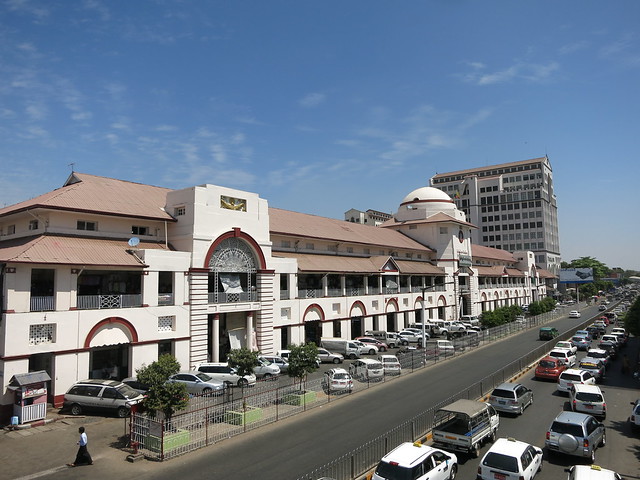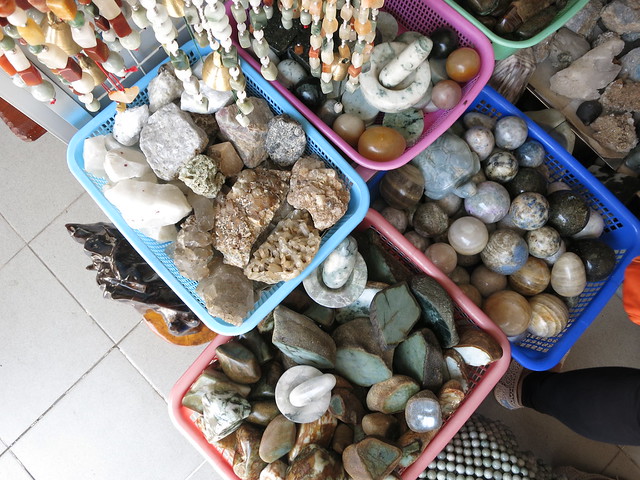I absolutely cannot resist a good bazaar.
And Bogyoke Aung San Market—located right smack in the heart of downtown Yangon and home to over 1,600 shops and stalls selling precious stones, jewelry, handicrafts, paintings, textiles, lacquerware and silverware, among others—definitely proved irresistible.
Located near the Sule Pagoda, Bogyoke Aung San Market is among the many charming colonial buildings in Yangon. Built and inaugurated in 1926 originally as “Scott Market” (don’t you just love Google?), Bogyoke is Myanmar’s most popular shopping destination and has never failed to attract shopaholic travelers like my sister and I.
It was a good thing we arrived in Yangon on a Sunday when shops were closed, because it turns out our hostel was a mere 15-minute walk away from the bazaar. Because we were due to leave for Kyaiktiyo early the following morning, it wasn’t until the last few hours of our trip that we got to check out the goodies sold in the market. And thank god for that—otherwise, we’d have probably ended up blowing a chunk of our dollars on gems and trinkets and have little left for our daily expenses. :D
Here are some snaps from our short trip to Yangon’s shopping mecca:



After we got our fill of the market (read: when we ran out of money), we spent our last few hours in Yangon walking around our neighbourhood, taking photos of Yangon’s colonial buildings.













Ohhh, the fabrics look so beautiful!! How were the prices? Have they succumbed to gouging tourists already? or are they keeping it real?
LikeLike
Hi Shelley! The prices of the fabrics are thereabouts the same as the ones I saw in Thailand already..maybe even a little more expensive if you’re buying using dollars–the conversion rate is $1 to 980 kyat but the locals tend to round off that number to a thousand. Gems are the best buys here, i heard :)
LikeLike
Interesting that the previous commenter asked about the fabrics. That picture with the colourful pieces of cloth was also one of the things that stood out most for me. They do look lovely – real silk, I hope?
I’m not much of a shopper myself, except for books (mum keeps complaining about how I buy too many books during my travels). I’ve also never been able to haggle; if the price seems reasonable I’ll pay whatever they’re asking for, even if I could have driven it down far with a little bargaining.
Having said that, I do enjoy the occasional market stroll. Even if I end up not buying anything, I find it provides an excellent opportunity to soak up the atmosphere and observe the locals at work. Sometimes the variety of goods on display can be bewildering – Nishiki Market in Kyōto comes to mind (http://withinstrikingdistance.wordpress.com/2013/07/06/field-report-kyoto-11-april-2013-part-23/) – but I suppose the stranger, more exotic, and less familiar the merchandise, the more enriching the experience can be.
LikeLike
The fabrics are an assortment of silk and cashmere. It was probably a blessing we were there for a quick trip (and that I was down to my last fifty dollars) as I’d have ended up buying the entire lot. :P
Loved your field report on Kyoto’s Nishiki Market. I am definitely doing a market-themed Japan trip sometime in the future—or at least squeeze in a couple of market visits in my itinerary. Sadly, I ended up bypassing the markets in Japan during my previous trips there. My group and I wanted to go to Nishiki, and Tsukiji Market in Tokyo, but as it was winter then, we ended up sleeping in. Must remedy that situation. :)
LikeLike